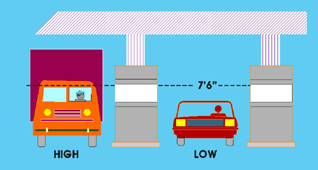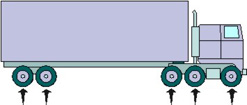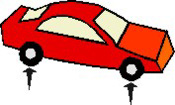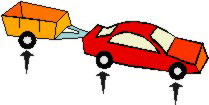Frequently Asked Questions (FAQs)
General Thruway FAQs
The Governor Thomas E. Dewey Thruway, the 570-mile superhighway crossing New York State, is one of the longest toll superhighway systems in the United States.
The Thruway's 426-mile mainline connects New York City and Buffalo, the state's two largest cities. The Thruway route from New York to the Pennsylvania line at Ripley is 496 miles long.
Other Thruway sections make direct connections with the Connecticut and Massachusetts turnpikes, New Jersey's Garden State Parkway and Interstate 287, and other major expressways that lead to New England, Canada, the Midwest and the South.
The Thruway includes Interstate 87 (New York City to Albany); Interstate 95 (New York City to Connecticut); Interstate 287 (connecting I-87 with I-95); Interstate 90 (both the Berkshire Spur, which connects I-87 with the Massachusetts Turnpike, and the mainline Thruway, which runs from Albany to the Pennsylvania border through Syracuse and Buffalo), and Interstate 190 (connecting Buffalo with Niagara Falls).
For a visual representation of the Thruway system, use our online map.
The first section of Thruway, a 115-mile stretch from Lowell to Rochester, opened on June 24, 1954. By December 23, 1960, all 559 miles of the original Thruway system were open.
The Cross Westchester Expressway and Interstate 84 were added to the Thruway system in 1991.
The maintenance and operation responsibilities of Interstate 84 were reverted to the New York State Department of Transportation on October 30, 2007 to achieve revenue neutrality after the discontinuation of toll collection at the Black Rock and City Line Barriers on October 30, 2006 (revenue neutrality was achieved through funding provided by the New York State Senate for one year. On October 11, 2010, operational maintenance of Interstate 84 was returned to the New York State Department of Transportation.
About 250 million vehicles travel more than 8 billion miles on the Thruway each year.
The Thruway Authority fills most of its positions via Civil Service lists, which are maintained by the NYS Department of Civil Service. ![]() Please visit their website for listings of upcoming Civil Service exams and job openings. We also have information on Thruway-specific job opportunities.
Please visit their website for listings of upcoming Civil Service exams and job openings. We also have information on Thruway-specific job opportunities.
If you are looking for more specific information, please call our Personnel/Recruitment line during business hours (Eastern time) at 518-436-2725.
Traveler FAQs
Yes, there are 10 centers located on the Thruway. Two more are located at Thruway interchanges, and five others can be found within a mile of interchanges.
Go to our Information Centers page for specific locations.
There are 27 service areas on the Thruway. Each offers a variety of food choices, as well as fuel and other amenities. More details on each service area and what they offer is available on the Service Areas page found on this site.
Ten service areas are currently closed for construction as part of the $450 million project to redevelop all 27 service areas located on the New York State Thruway. Fuel services remain available at all locations during construction. More on the project and a list of the closures can be found on the Service Area Redevelopment Project page found on this site.
The Thruway Winter Traveler Advisory is available during winter months.
The Thruway also maintains a toll-free number for customers to call for this information: 1-800-THRUWAY (1-800-847-8929). The recorded message is updated as conditions change and patrons can choose any region for which they would like weather information.
Other important Thruway phone numbers can be found on this site's Phone Numbers page.
Motorists can download the free mobile app to access the latest road conditions in real time. TRANSalert emails are also available to provide real-time information about incidents that may affect travel on the Thruway. Motorists can sign up for TRANSalerts here.
Motorists may call 1-800-POTHOLE (1-800-768-4653) to report potholes on any State-owned highway, including the Thruway, except in New York City, where motorists may report potholes by dialing 311. Potholes on county or town roads, city and village streets, or private roadways should be reported to the appropriate owner.
Calls received by the hotline are directed to the closest Department of Transportation or Thruway Authority maintenance facility, from which a maintenance crew will be dispatched as soon as weather conditions and other factors permit.
Individuals calling the hotline will be asked to provide detailed information regarding the location of the pothole, including: the name of the community or county, state route number or interstate; closest reference marker number; closest exit number; the direction of travel and the nearest landmark or crossroad.
Thruway Tolls FAQs
Tolls on the New York State Thruway are calculated according to the height of the vehicle, total number of axles of a vehicle, and distance traveled.
The Authority provides a Toll & Distance Calculator which will estimate tolls, distance and travel time for entry and exit points anywhere on the Thruway system for all vehicle classifications. Patrons are required to enter the height and number of axels on the vehicle.

Measurement is taken at the highest point of the vehicle over the first two axles. Typical home garages feature 7 feet high doors. If your vehicle fits in a standard garage, then it is probably under 7 feet 6 inches. If you are unable to measure the height of the vehicle, check your owner's manual or manufacturer documentation.
An axle is a shaft around which a wheel or a pair of wheels revolve. Most passenger cars are considered to have 2 axles for classification purposes. To determine the number of axles on the vehicle or vehicle combination, look at the vehicle from the side profile and count the number wheels or pair of wheels from front to back.

5 axles

2 axles

3 axles
Vehicle Classification information and Toll Schedule Charts are available online, by calling the Authority's Division of Toll Collection at (518) 436-2805, or by emailing the Authority by using the online contact form.
No. Non-permanent items (examples: kayak, bicycles, ladder, snow board, luggage carrier) carried on a passenger vehicle's roof (Class 2L, 3L, or 4L) are not considered when determining vehicle classification.
No. Non-permanent items carried in the bed of a pick-up truck (Class 2L, 3L, or 4L) are not considered when determining vehicle classification.
No. Dual rear wheels are not a determining factor for vehicle classification. Classification will be based on height and axles regardless of the number of tires on each axle.
The number of passengers is not a determining factor for vehicle classification. Classification is based on height and axles, regardless of the passenger capacity.
Conversion vans are classified as a passenger vehicle (Class 2L).
However, if your conversion van has features similar to a "motorhome," for example, a cook top/range, microwave, a sleeping area, or tub/shower/toilet amenities, this vehicle would not be classified as a traditional passenger vehicle (2L), but rather a motorhome, while traveling the New York State Thruway.
The Thruway Authority does offer a Thruway Motorhome Discount Plan via E-ZPass.
Vehicle classification is based on the height of the vehicle over the first two axles, including any trailer, and the total number of axles. A vehicle's combination is considered HIGH if the height of the vehicle over the first two axles is 7'6" or greater.
For example, a 2-axle pick-up truck with a 2-axle 5th wheel trailer, 7'6" or greater, which extends forward over the rear axle, would be classified as a 4H. Using this same logic, a 2-axle pick-up truck with a 3-axle 5th wheel trailer, 7'6" or greater, would be classified as a 5H.
E-ZPass discounts are available for these vehicle combinations; however, special tags are required that must be programmed specifically for the specific vehicle combination. To be eligible, customers must first have an established E-ZPass account with the New York E-ZPass Customer Service Center.
Discounted rates are not available to non-E-ZPass customers.
Cashless Tolling is a free flowing tolling system that operates without toll booths or barriers. It saves motorists time and money, improves safety on the roadway and reduces congestion and air pollution. Cashless tolling was implemented on the Thruway system-wide in 2020. Tolls are collected either by E-ZPass ![]() or through Tolls By Mail
or through Tolls By Mail ![]() .
.
Go to our Cashless Tolling section for more information.
The Thruway Authority uses Tolls By Mail ![]() to bill customers without an E-ZPass, after they travel on the Thruway. As motorists travel under a gantry, special equipment takes an image of the vehicles’ license plate. A toll bill is mailed to the registered owner of the vehicle at the address on file with the Department of Motor Vehicles. Payment can also be made on the Tolls By Mail
to bill customers without an E-ZPass, after they travel on the Thruway. As motorists travel under a gantry, special equipment takes an image of the vehicles’ license plate. A toll bill is mailed to the registered owner of the vehicle at the address on file with the Department of Motor Vehicles. Payment can also be made on the Tolls By Mail ![]() website or by calling the customer service center at 1-844-826-8400.
website or by calling the customer service center at 1-844-826-8400.
Go to our Cashless Tolling section for more information.
There are two reasons why an E-ZPass customer would receive a Toll Bill:
- An E-ZPass tag was not detected when traveling under a toll gantry; AND
- The license plate was not listed on their E-ZPass account.
To avoid receiving future Toll Bills, customers must ensure their tag is mounted properly and their license plate(s) are added to their E-ZPass account.
To pay the Toll Bill, follow the instructions provided on the toll bill.
If your E-ZPass tag isn’t read when traveling on the Thruway, an image of the license plate is taken and the associated toll will be charged at the Tolls by Mail rate. If the license plate is on your E-ZPass account, the toll will post directly to your account using the license plate. If the license plate is not on your E-ZPass account, the registered owner of the vehicle will receive a Toll Bill.
You can avoid paying higher tolls by ensuring your tag is properly mounted on the windshield. Instructions for properly mounting the tag can be found at Thruway Tag Mounting Instructions. Mounting strips are free and can be obtained by requesting them through your online account at E-ZPassNY.com. ![]()
E-ZPass and Discount FAQs
E-ZPass is an electronic toll collection system which allows motorists to pre-pay tolls and attach a small electronic device to their vehicles. Tolls are automatically calculated and deducted from the pre-paid accounts as E-ZPass customers travel under gantries on the Thruway.
The Thruway Authority was the first toll agency in the Northeast to offer electronic toll collection to its customers. View of map of where E-ZPass is accepted. ![]()
E-ZPass information and applications are available online at www.e-zpassny.com. ![]()
NY E-ZPass customers pay a lower rate than Tolls by Mail customers. NY E-ZPass customers may also be eligible for additional discount plans and do not pay the differential Non-NY E-ZPass and Tolls by Mail Customers pay, making it the most affordable payment option available to all of our motorists who sign up for a tag.
E-ZPass is both convenient and cost-saving. You can become an E-ZPass customer by purchasing a NY E-ZPass On-the-Go tag at participating retail locations across the state, online at www.e-zpassny.com ![]() or applying through the mail
or applying through the mail ![]() .
.
Only Disabled Veterans holding a FEE EXEMPT registration can qualify to travel the Thruway toll free. Qualification does not depend on VA plates.
More information is available on the Disabled Veterans page.
Current E-ZPass customers can add discount plans by logging into their online account at www.e-zpassny.com ![]() or can call 1-800-333-8655 to sign up for a commuter discount plan. Customers enrolling in E-ZPass for the first time may choose a commuter plan during the E-ZPass application process.
or can call 1-800-333-8655 to sign up for a commuter discount plan. Customers enrolling in E-ZPass for the first time may choose a commuter plan during the E-ZPass application process.
Discounts are available through the E-ZPass program. Proof of vehicle registration is required for both plans. Motorcycles are charged half of the cash toll rate. Motor homes receive the passenger vehicle rate based on the number of axles on the motor home. To enroll in the motorcycle or motor home discount plan call 1-800-333-8655.
Mario M. Cuomo Bridge Resident (MCR) Discount Plan FAQs
The MCR Plan is a Tag specific plan that provides eligible residents of Rockland and Westchester county a toll rate of $5.00 per trip for passenger vehicles with no minimum trips required. Only E-ZPass Tag transactions receive the discount.
In order to qualify you must meet the following requirements:
- E-ZPass account must be with E-ZPass NY
- E-ZPass address must be in Rockland or Westchester county
- Discount is associated with a specific E-ZPass Tag(s) based on eligible license plates on your Account
- For each E-ZPass Tag with an associated MCR plan, a unique license plate must be registered in Rockland or Westchester county
Not necessarily. This plan is associated with a specific E-ZPass Tag and may only be used in vehicles that are listed on your E-ZPass account which are registered in Rockland or Westchester county. When you have more E-ZPass Tags than eligible license plates not all E-ZPass Tags will receive the discount.
Login to your account at e-zpassny.com and choose Plans to add a Tag Specific plan to your existing account.
Login to your account at e-zpassny.com and choose Vehicles & Tags. The license plate(s) that are listed will have an MCR in the Resident Eligible column.
If you recently registered your vehicle in Rockland or Westchester county, you can upload a copy of your registration. Click on Account Inquiry and choose Residency Plan in the Topic drop-down. Complete the rest of the inquiry form to attach a copy of your registration.
You will continue to be charged the commuter rate.
No. The discount is not automatically added.
There is no additional cost to add the MCR plan.
Governor Mario M. Cuomo Bridge FAQs
The Governor Mario M. Cuomo Bridge connects Westchester and Rockland counties in New York, approximately 20 miles north of Manhattan. The three-mile span crosses the Hudson River at one of its widest points, serving as a vital artery for Hudson Valley residents, commuters, travelers and commercial traffic. The cable-stayed crossing replaced the 62-year-old Tappan Zee Bridge as part of the $3.98 billion New NY Bridge Project ![]() , one of the largest single design-build contracts for a transportation project in the United States. The new bridge fully opened to traffic in 2018. Carrying more than 50 million vehicles each year, the twin-span bridge is a key part of the New York State Thruway Authority’s 570-mile superhighway system. Each span features four general traffic lanes, emergency shoulders and a dedicated bus lane on the New York State Thruway (I-87/I-287).
, one of the largest single design-build contracts for a transportation project in the United States. The new bridge fully opened to traffic in 2018. Carrying more than 50 million vehicles each year, the twin-span bridge is a key part of the New York State Thruway Authority’s 570-mile superhighway system. Each span features four general traffic lanes, emergency shoulders and a dedicated bus lane on the New York State Thruway (I-87/I-287).
Yes. Bicyclists and pedestrians can enjoy a 12-foot-wide shared use path on the northern side of the westbound span, connecting the villages of Tarrytown in Westchester County and South Nyack in Rockland County. The 3.6-mile path features six scenic overlooks at regular intervals, public art, visitor parking, restrooms and other amenities at each landing. Information on how to access the path can be found on the bridge’s new website ![]() .
.
With its signature blue overlay, the 12-foot wide shared use path extends 3.6 miles from its Westchester Landing in the village of Tarrytown, across one of the widest points of the Hudson River, to its Rockland Landing in the village of South Nyack. Located on the northern side of the bridge’s westbound span, you’ll encounter six scenic overlooks, digital kiosks, interpretive signage and 10 works of public art. Visitor parking, food, restrooms, bicycle repair stations and other amenities, along with connectivity to local bike and pedestrian networks, are also available at both landings.
Yes. There are dedicated bus lanes on each span. The bus lane is located on the right side of the road, between the general travel lanes and the outside shoulder. Only vehicles with seating for 15 or more passengers are permitted to use the bus lanes. These include Hudson Link buses, charter buses, school buses, and other regional public transit buses. New York State Police are responsible for enforcing the proper use of the bus lane on the bridge. The first violation will carry a fine of $150, and the penalty would escalate for any repeat violations within an 18-month period.
Hudson Link is an enhanced bus service that takes commuters across the Governor Mario M. Cuomo Bridge and within the I-287 corridor. It features new, world-class buses and intelligent transportation management technology with real-time traffic information for commuters. Hudson Link, run by Transdev, provides more than 230 one-way rides per day between Rockland and Westchester counties with an estimated annual ridership of more than 400,000. Commuters are taken to Metro-North stations in Tarrytown or White Plains, both in Westchester County. This summer, Hudson Link provided a free weekend shuttle to the path. For more information on the service and to access the transit schedules, visit www.ridehudsonlink.com ![]() .
.
The Governor Mario M. Cuomo Bridge website ![]() features information about the bridge, the shared-use path, its six themed overlooks and public art works. For real-time updates about the path, follow us on Twitter
features information about the bridge, the shared-use path, its six themed overlooks and public art works. For real-time updates about the path, follow us on Twitter ![]() or connect with us on Instagram
or connect with us on Instagram ![]() .
.